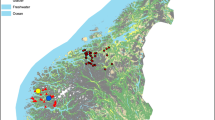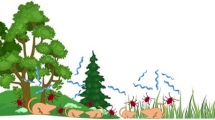Abstract
Larvae of the trombiculid mite Neotrombicula autumnalis were collected at 18 sites in and around Bonn, Germany, to be screened for infection with Borrelia burgdorferi s.l. by means of PCR. Questing larvae numbering 1380 were derived from the vegetation and 634 feeding ones were removed from 100 trapped micromammals including voles, mice, shrews and hedgehogs. In a laboratory infection experiment, a further 305 host-seeking larvae from the field were transferred onto Borrelia-positive mice and gerbils, and examined for spirochete infection at various intervals after repletion. In three cases borrelial DNA could be amplified from the mites: (1) from a larva feeding on a wild-caught greater white-toothed shrew (Crocidura russula), (2) from a pool of four larvae feeding on a B. garinii-positive laboratory mouse, and (3) from a nymph that had fed on a B. afzelii-positive laboratory gerbil as a larva. In the first case, borrelial species determination by DNA hybridization of the PCR product was only possible with a B. burgdorferi complex-specific probe but not with a species-specific one. In the second case, probing showed the same borrelial genospecies (B. garinii) as the laboratory host had been infected with. In the latter case, however, DNA hybridization demonstrated B. valaisiana while the laboratory host had been infected with B. afzelii. Subsequent DNA sequencing confirmed much higher similarity of the PCR product to B. valaisiana than to B. afzelii indicating an infection of the mite prior to feeding on the laboratory host. The negligible percentage of positive mites found in this study suggests that either the uptake of borrelial cells by feeding trombiculids is an extremely rare event or that ingested spirochetes are rapidly digested. On the other hand, the results imply a possible transstadial and transovarial transmission of borreliae once they are established in their trombiculid host. However, unless the transmission of borreliae to a given host is demonstrated, a final statement on the vector competence of trombiculid mites is not possible.
Similar content being viewed by others
References
Andreadis T.G., Anderson J.F. and Vossbrinck C.R. 2001. Mosquito surveillance for West Nile virus in Connecticut, 2000: isolation from Culex pipiens, Cx. restuans, Cx. salinarius, and Culiseta melanura. Emerg. Infect. Dis. 7: 670–674.
Barthold S.W., de Souza M.S., Janotka J.L., Smith A.L. and Persing D.H. 1993. Chronic Lyme borreliosis in the laboratory mouse. Am. J. Pathol. 143: 959–971.
Blanc G., Joyeux C. and Bruneau J. 1952. Observations sur les larves de Trombicula autumnalis (Shaw) dans le centre de la France. Recherches sur leur role possible dans la transmission de la maladie de Derrick-Burnet (Q-Fever). Arch. Inst. Pasteur Maroc 4: 314–325.
Cook G. 1996. Manson's Tropical Diseases. 20th edn. W.B. Saunders, London, pp. 808–810.
Daniel M. 1961. The bionomics and developmental cycle of some chiggers (Acariformes, Trombiculidae) in the Slovak Carpathians. Čs. parasitol. 8: 31–118.
Ewing H.E. 1944. The trombiculid mites (chigger mites) and their relation to disease. J. Parasitol. 30: 339–365.
Fernández-Soto P., Pérez-Sánchez R. and Encinas-Grandes A. 2001. Molecular detection of Ehrlichia phagocytophila genogroup organisms in larvae of Neotrombicula autumnalis (Acari: Trombiculidae) captured in Spain. J. Parasitol. 87: 1482–1483.
Gern L., Siegenthaler M.C., Hu M., Leuba-Garcia S., Humair P.F. and Moret J. 1994. Borrelia burgdorferi in rodents (Apodemus flavicollis and A. sylvaticus): duration and enhancement of infectivity for Ixodes ricinus ticks. Eur. J. Epidemiol. 10: 75–80.
Grinbergs A.R. 1959. Krasnotelki Trombicula zachvatkini Schlug. kak vozmožnyj epidemioločeskij faktor v Latvijskoj SSR. Des. sovešč. po parazitol. probl. i prirodnoočag. bolez., fasc. 2: 59.
Guy E.C. and Stanek G. 1991. Detection of Borrelia burgdorferi in patients with Lyme disease by the polymerase chain reaction. J. Clin. Pathol. 44: 610–611.
Hoffmann G. 1984. Milbenbefall bei Menschen und Haustieren (II). Pharm. Rundschau 9/84: 48–53.
Houck M.A., Qin H. and Roberts H.R. 2001. Hantavirus transmission: potential role of ectoparasites. Vect. Borne Zoon. Dis. 1: 75–79.
Hubálek Z. and Halouzka J. 1997. Distribution of Borrelia burgdorferi sensu lato genomic groups in Europe, a review. Eur. J. Epidemiol. 13: 951–957.
Hubert A.A. and Baker H.J. 1963. Studies on the habitats and populations of Leptotrombidium akamushi and L. deliense in Malaya (Acari, Trombiculidae). Am. J. Hyg. 78: 131–142.
Janetzki C., Kahl O. and Knülle W. 1992. The Mongolian gerbil, Meriones unguiculatus, as a laboratory reservoir for Borrelia burgdorferi. In: Munderloh U.G. and Kurtti T.J. (eds) Proceedings of the 1st International Conference on Tick-Borne Pathogens at the Host-Vector Interface: An Agenda for Research. St. Paul, Minnesota, USA, 15–18 September 1992, p. 143
Jones B.M. 1950. The penetration of the host tissue by the harvest mite, Trombicula autumnalis Shaw. Parasitology 40: 247–260.
Kahl O. 1992. The Mongolian gerbil, Meriones unguiculatus, as a laboratory host for immature ixodid ticks. In: Munderloh U.G. and Kurtti T.J. (eds) Proceedings of the 1st International Conference on Tick-Borne Pathogens at the Host-Vector Interface: An Agenda for Research. St. Paul, Minnesota, USA, 15–18 September 1992, p. 300.
Kampen H., Rötzel D, Kurtenbach K., Maier W.A. and Seitz H.M. 2004. Substantial rise in the prevalence of Lyme borreliosis spirochetes in a region of western Germany over a ten-year period. App. Environ. Microbiol.in-press.
Kepka O. 1965. Die Herbstmilbe (Neotrombicula autumnalis). Angew. Parasitol. 6: Merkblatt Nr. 12 über angewandte Parasitenkunde und Schädlingsbekämpfung, 13 p.
Kurtenbach K., Dizij A., Seitz H.M., Margos G., Moter S.E., Kramer M.D., Wallich R., Schaible U. and Simon M.M. 1994. Differential immune responses to Borrelia burgdorferi in European wild rodent species influence spirochete transmission to Ixodes ricinus L. (Acari: Ixodidae). Infect. Immun. 62: 5344–5352.
Kurtenbach K., Kampen H., Dizij A., Arndt S., Seitz H.M., Schaible U.E. and Simon S.S. 1995. Infestation of rodents with larval Ixodes ricinus (Acari: Ixodidae) is an important factor in the transmission cycle of Borrelia burgdorferi s.l. in German woodlands. J. Med. Entomol. 32: 807–817.
Kurtenbach K., Peacey M., Rijpkema S.G.T., Hoodless A.N., Nuttall P.A. and Randolph S.E. 1998. Differential transmission of the genospecies of Borrelia burgdorferi sensu lato by game birds and small rodents in England. Appl. Environ. Microbiol. 64: 1169–1174.
Kurtenbach K., De Michelis S., Sewell H.-S., Etti S., Schäfer S.M., Hails R., Collares-Pereira M., Santos-Reis M., Haninçová K., Labuda M., Bormane A. and Donaghy M. 2001. Distinct combinations of Borrelia burgdorferi sensu lato genospecies found in individual questing ticks from Europe. Appl. Environ. Microbiol. 67: 4926–4929.
Kurtenbach K., De Michelis S., Etti S., Schäfer S.M., Sewell H.-S., Brade V. and Kraiczy P. 2002. Host association of Borrelia burgdorferi sensu lato — the key role of host complement. Trends Microbiol 10: 74–79.
Le Gac P. et al. 1953. Cited in Daniel (1961).
Liebisch G., Sohns B. and Bautsch W. 1998. Detection and typing of Borrelia burgdorferi sensu lato in Ixodes ricinus ticks attached to human skin by PCR. J. Clin. Microbiol. 36: 3355–3358.
Maiwald M., Oehme R., March O., Petney T.N., Kimmig P., Naser K., Zappe H.A., Hassler D. and von Knebel Doeberitz M. 1998. Transmission risk of Borrelia burgdorferi sensu lato from Ixodes ricinus ticks to humans in southwest Germany. Epidemiol. Infect. 121: 103–108.
Nakayama Y. and Spielman A. 1989. Ingestion of Lyme disease spirochetes by ticks feeding on infected hosts. J. Infect. Dis. 160: 166–167.
Navajas M., Gutierrez J., Bonato O., Bolland H.R. and Mapangou-Divassa S. 1994. Intraspecific diversity of the Cassava Green Mite Mononychellus progressivus (Acari: Tetranychidae) using comparisons of mitochondrial and nuclear ribosomal DNA sequences and cross-breeding. Exp. Appl. Acarol. 18: 351–360.
Oehme R., Hartelt K., Backe H., Brockmann S. and Kimmig P. 2002. Foci of tick-borne diseases in southwest Germany. Int. J. Med. Microbiol. 291 (Suppl.33): 22–29.
Paul H., Gerth H.J. and Ackermann R. 1986. Infectiousness for humans of Ixodes ricinus containing Borrelia burgdorferi. Zentralbl. Bakteriol. Hyg. A263: 673–676.
Philip C.B. 1948. Tsutsugamushi disease (scrub typhus) in World War II. J. Parasitol. 34: 169–191.
Piesman J., Oliver J.R. and Sinsky R.J. 1990. Growth kinetics of the Lyme disease spirochete (Borrelia burgdorferi) in vector ticks (Ixodes dammini). Am. J. Trop. Med. Hyg. 42: 352–357.
Rath P.M., Ibershoff B., Mohnhaupt A., Albig J., Eljaschewitsch B., Jurgens D., Horbach I. and Fehrenbach F.J. 1996. Seroprevalence of Lyme borreliosis in forestry workers from Brandenburg, Germany. Eur. J. Clin. Microbiol. Infect. Dis. 15: 372–377.
Rijpkema S.G.T., Molkenboer M.J.C.H., Schouls L.M., Longejan F. and Schellekens J.F.P. 1995. Simultaneous detection and genotyping of three genomic groups of Borrelia burgdorferi sensu lato in Dutch Ixodes ricinus ticks by characterization of the amplified intergenic spacer region between 5S and 23S rRNA genes. J. Clin. Microbiol. 33: 3091–3095.
Sayers M.H.P. and Hill I.G.W. 1948. The occurrence and identification of the typhus group of fevers in South East Asia Command. J. R. Army Med. Corps 90: 6–22.
Schwan T.G. and Piesman J. 2002. Vector interactions and molecular adaptations of Lyme disease and relapsing fever spirochetes associated with transmission by ticks. Emerg. Infect. Dis. 8: 115–121.
Schwartz I., Wormser G.P., Schwartz J.J., Cooper D., Weissensee P., Gazumyan A., Zimmermann E., Goldberg N.S., Bittker S., Campbell G.L. and Pavia C.S. 1992. Diagnosis of early Lyme disease by polymerase chain reaction amplification and culture of skin biopsies from erythema migrans lesions. J. Clin. Microbiol. 30: 3082–308.
Simonová V. 1977. Laboratory culturing of chiggers (Acarina: Trombiculidae). Folia Parasitol. 24: 285–288.
Sinsky R.J. and Piesman J. 1989. Ear punch biopsy method for detection and isolation of Borrelia burgdorferi from rodents. J. Clin. Microbiol. 27: 1723–1727.
Steere A.C. 2001. Lyme disease. New Engl. Med. J. 345: 115–125.
Strle F., Nelson J.A., Ruzic-Sabljic E., Cimperman J., Lotric-Furlan S., Cheng Y., Picken M.M., Trenholme G.M. and Picken R.N. 1996. European Lyme borreliosis: 231 culture-confirmed cases involving patients with erythema migrans. Clin. Infect. Dis. 23: 61–65.
Tamura A., Ohashi N., Urakami H. and Miyamura S. 1995. Classification of Rickettsia tsutsugamushi in a new genus, Orientia gen. nov., as Orientia tsutsugamushi comb. nov. Int. J. Syst. Bacteriol. 45: 589–591.
Toutoungi L.N. and Gern L. 1993. Ability of transovarially and subsequent transstadially infected Ixodes hexagonus ticks to maintain and transmit Borrelia burgdorferi in the laboratory. Exp. Appl. Acarol. 17: 581–586.
Traub R. and Wisseman Jr. C.L. 1974. The ecology of chigger-borne rickettsiosis (scrub typhus). J. Med. Entomol. 11: 237–303.
Vysotskaya S.O. and ťluger E.G. 1953. Licinki krasnotelok-parazity gryzunov Leningradskoj oblasti. Parazitol. sbornik 15: 345–352.
Walsh P.S., Metzger D.A. and Higuchi R. 1991. Chelex 100 as a medium for simple extraction of DNA for PCR-based typing from forensic material. BioTechniques 10: 506–513.
Williams R.W. 1944. A contribution to our knowledge of the bionomics of the common North American chigger, Eutrombicula alfreddugesi (Oudemans), with a description of a rapid collection method. Am. J. Trop. Med. 26: 243–250.
Wu G., Zhang Y., Guo H., Jiang K., Zhang J. and Gan Y. 1996. The role of Leptotrombidium scutellare in the transmission of human disease. Chin. Med. J. 109: 670–673.
Zappe H.A., Hassler D., Oehme R., Stutzke O. and Maiwald M. 2002. The value aof antibiotic prophylaxis and the risk of Borrelia burgdorferi transmission after tick bite. Eur. J. Gen. Pract. 8: 125.
Zhioua E., Aeschlimann A. and Gern L. 1994. Infection of field-collected Ixodes ricinus (Acari: Ixodidae) larvae with Borrelia burgdorferi in Switzerland. J. Med. Entomol. 32: 807–817.
Zhioua E., Rodhain F., Binet P. and Perez-Eid C. 1997. Prevalence of antibodies to Borrelia burgdorferi in forestry workers of Ile de France, France. Eur. J. Epidemiol. 13: 959–962.
Author information
Authors and Affiliations
Corresponding author
Rights and permissions
About this article
Cite this article
Kampen, H., Schöler, A., Metzen, M. et al. Neotrombicula autumnalis (Acari, Trombiculidae) as a vector for Borrelia burgdorferi sensu lato?. Exp Appl Acarol 33, 93–102 (2004). https://doi.org/10.1023/B:APPA.0000029975.92510.90
Issue Date:
DOI: https://doi.org/10.1023/B:APPA.0000029975.92510.90




